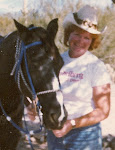Sometimes the trails held unexpected surprises.
Summer in the desert is hot and daytime temperatures can reach 110 degrees or more. Life here adjusts, everything trying to escape the searing daytime heat.
Desert air is wrung dry of moisture with humidity hovering around 7%, giving rise to the tourism board's "but it's a dry heat!" slogan. To dodge the worst of the heat animals become nocturnal and people shift outdoor activities to early morning or late afternoons.
Riding was no different. Trail rides now left at the crack of dawn or late afternoon to catch the sunset.
On one such morning I escorted a special ride. A group of retired lady school teachers wanted to really see the desert from a different perspective. They got more than they bargained for.
We mounted up and headed out with the morning sun just cresting the Catalina mountains to the east. It was cool and the air filled with bird song and the happy chatter of a dozen ladies. The trail wound through native vegetation and each unique cactus was pointed out to the eagerly attentive riders. Weaving between two-story Saguaro cacti, the trail began to climb.
Soon we were riding along foothill ridges heading for loftier mountain heights above. I was going to a special overview, a place that was higher in the Tucson Mountains, which offered a spectacular view of the Santa Cruz valley far below. This overview was really the remains of an old mine site. An area cleared and leveled in pioneer times in a search for gold. Although a brown scar on the green mountainside, it offered a breathtaking view, but it wasn't the only view.
I led the group off the narrow twisting trail and onto an old roadway which led upwards to the mine. It was a steep road which curved as it climbed. Rounding a blind bend, we met an unusual surprise.
The isolated mine was deep into the mountains. The only road traffic was from nature. Sometimes I saw a rattlesnake, sometimes a coyote or two but today we encountered a once in a lifetime meeting.
Nakedus jogus was before us.
As we rounded the bend we encountered a jogger. A lone man who was lost in the joy of running, who thought himself completely alone. A man with head phones and unable to hear our approach. A man wearing running shoes and... nothing more.
Horses are very suspicious of anything new or unusual. It is a survival strategy to keep from being eaten. The jogger was suspicious, new and unusual. As herd animals they acted as of one mind. They all spooked.
A dozen horses found a dozen ways to bolt.
I never knew what became of the jogger. He just disappeared from my view. My attention was focused on the horses with their precious novices aboard. By the time I collected my group again, he was gone.
We continued once more to the overview amidst a twitter of excited talk. The unusual wildlife had the ladies all agog. The view was incredible as expected with nary a jogger in sight. He was gone from view but forever etched into the mind.
Our return was uneventful. No cactus or coyote could now compare to the natural vistas we had just seen.
The ladies created a memory that day, to savor in the years to come, and the ride was the highlight of their trip.This glimpse of our desert wonders was one to never forget.



